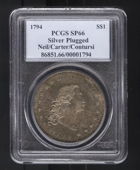
PREV ARTICLE
NEXT ARTICLE
FULL ISSUE
PREV FULL ISSUE
ARTICLE HIGHLIGHTS 1794 DOLLAR RESEARCH EFFORTS
Donn Pearlman published a lengthy article in Numismatic News about the recently-sold 1794 dollar. It describes the history of numismatic opinion surrounding the possibility that it could actually be the first such coin struck. Below is only an excerpt, so be sure to read the whole article online.
-Editor
It’s also a lesson in numismatic market cycles. When legendary dealer B. Max Mehl sold the Will W. Neil collection in 1947, this coin brought $1,250, an amazing bargain by today’s value even when 66 years of inflation are factored in. But the coin actually dropped in price from $264,000 at its 1984 auction by Stack’s to $209,000 in a 1986 auction by Superior Galleries. Now it’s making international headlines for the $10,016,875 winning bid by Legend Numismatics at the Jan. 24 Stack’s Bowers Galleries auction. For eight years I had a front row seat for many events involving the Neil/Carter/Contursi 1794 dollar and served as a consultant to the coin’s owner, Steven L. Contursi, President of Rare Coin Wholesalers. It was also during that time that building consensus among experienced numismatists and the accumulation of their expert comments added significantly more credence to the theory that this particular coin might be the very first silver dollar struck by the U.S. Mint. There is no known contemporary documentation that this, indeed, was the first silver dollar struck. There’s no in-depth New York Times story from the scene about the Mint striking the first dollar denomination coins on Oct. 15, 1794, as the paper wasn’t founded until 1851. But theories about the significance of this particular coin have been around for decades. For example, the description of the dollar in the January 1984 Stack’s auction of coins from the collection of Amon G. Carter Jr. stated: “The Carter 1794 silver dollar is a twin to the copper dollar (now in the Smithsonian Collection), both in surface and strike. It is perfectly conceivable that this coin was the very first 1794 silver dollar struck.” In 2003 and 2004, arrangements were made by Contursi for more than a dozen numismatic experts to closely inspect the coin outside its PCGS encapsulation holder. The consensus of the independent experts was that:
As the earliest known die state, it was certainly among the first few made.
Earlier E-Sylum discussions cautioned against claims that it was actually THE FIRST. The qualifying word "may" was properly used here - it "may be the first U.S. silver dollar struck." The problem comes when others (especially mainstream news outlets) that pick up a story, gloss over or drop the qualifiers, and declare that the coin IS the first. In the absence of proof, no one can say that for sure.
The connection to the 1794 copper pattern hasn't been discussed here before, so here's another excerpt. -Editor In 2003, Contursi brought the coin to the Smithsonian to compare it to the 1794 copper pattern in the National Numismatic Collection. Dr. Richard Doty, Numismatic Curator of the Smithsonian’s National Museum of American History, has emphatically said there’s no proof it’s the very first silver dollar, and has even joked on more than one occasion, that “we are moving from the realm of numismatics into that of theology.” However, in a letter to Contursi following the side-by-side examination of the coin with the 1794 dollar copper trial strike in the museum’s collection, Dr. Doty wrote: “The die states are the same on our copper trial and the silver specimen. Neither displays evidence of a die clash, which means at least that each was coined very early in the run. The silver piece shows some evidence of having been struck on a polished planchet, as does our copper trial. Our experience is that you don’t polish planchets for production-run coins; there would be no point. All of these points suggest that the piece was intended for presentation, which suggests that it was one of the first 1794 dollars struck.”
Rightly, there are qualifying words here, too: "suggests" that it was "one of". But there are plenty of other unqualified factors that make this a terrific and important coin regardless, including that it is the only one with the silver plug. Be sure to check out the rest of the article on NumisMaster.
-Editor
To read the complete article, see: 1794 Flowing Hair Dollar Shows Record Price, Record Effor (numismaster.com/ta/numis/Article.jsp?ArticleId=26507) To read the earlier E-Sylum article, see: ON THE 'FIRST' 1794 DOLLAR (www.coinbooks.org/esylum_v16n05a14.html)
For more on prior owner Martin Logies' book, see:
1794 DOLLAR BOOK PUBLISHED
(www.coinbooks.com/esylum_v07n33a08.html)
The Numismatic Bibliomania Society is a non-profit organization promoting numismatic literature. See our web site at coinbooks.org. To submit items for publication in The E-Sylum, write to the Editor at this address: whomren@gmail.com To subscribe go to: https://my.binhost.com/lists/listinfo/esylum All Rights Reserved. NBS Home Page Contact the NBS webmaster 
|
